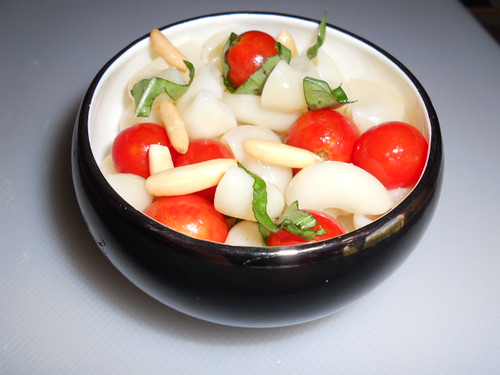Guilia Melucci is a sad woman. A victim of the New York dating game, she runs through one man after the other, searching for her true love. When it is amply clear to any reader of "I loved, I lost, I made spaghetti" (or the spaghetti book, as the members of This Book Makes Me Cook have taken to call it) that the first and the only love of her life is the food she cooks.
The book is chock full of recipes, almost all a nod to Ms. Melucci's Italian past. And quite unlike the weak, average story the recipes are written in a witty and charming manner, reflecting the author's mood at the time. Like the Ineffectual Eggplant Parmigiana, cooked for two in a flailing relationship, "plus the three other people you wish were there to help keep the conversation going". Or the yorkshire puddings that deflate rapidly, like expectations!
I picked a dish from Guilia's happy times. The beginning of a relationship, when she's cooking bright, sunny dishes for two. This orzo salad, in fact, is from the sunniest relationship in the book. I made it with elbow macaroni instead of orzo but the flavors really work, no matter what pasta shape you choose.
Boil 1/2 cup pasta as per package directions until it is cooked but still have some bite. Drain and add a tbsp of olive oil. Once the pasta cools, mix in a cup of cherry tomatoes, 1/4 cup shredded basil, 2 tbsp toasted pine nuts, a tsp of white wine vinegar plus salt and pepper to your taste.
For November, we are reading "It must've been something I ate" by Jeffrey Steingarten. Do drop me a line if you would like to read with us.
The book is chock full of recipes, almost all a nod to Ms. Melucci's Italian past. And quite unlike the weak, average story the recipes are written in a witty and charming manner, reflecting the author's mood at the time. Like the Ineffectual Eggplant Parmigiana, cooked for two in a flailing relationship, "plus the three other people you wish were there to help keep the conversation going". Or the yorkshire puddings that deflate rapidly, like expectations!
I picked a dish from Guilia's happy times. The beginning of a relationship, when she's cooking bright, sunny dishes for two. This orzo salad, in fact, is from the sunniest relationship in the book. I made it with elbow macaroni instead of orzo but the flavors really work, no matter what pasta shape you choose.
Boil 1/2 cup pasta as per package directions until it is cooked but still have some bite. Drain and add a tbsp of olive oil. Once the pasta cools, mix in a cup of cherry tomatoes, 1/4 cup shredded basil, 2 tbsp toasted pine nuts, a tsp of white wine vinegar plus salt and pepper to your taste.
For November, we are reading "It must've been something I ate" by Jeffrey Steingarten. Do drop me a line if you would like to read with us.


Comments